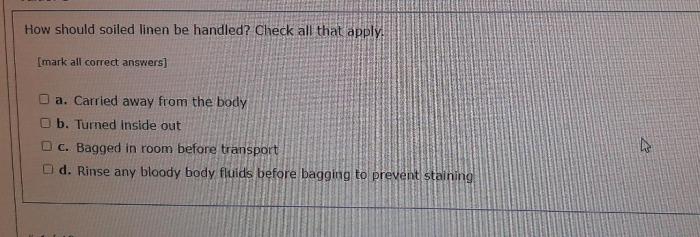How should soiled linen be carried? This question is of paramount importance in healthcare settings, where proper handling of soiled linen is crucial for infection control and maintaining hygiene. This article provides comprehensive guidelines for handling, packaging, transporting, storing, and disposing of soiled linen in a safe and efficient manner, ensuring the well-being of patients, staff, and the environment.
Soiled linen, if not handled properly, can harbor pathogens and pose significant infection risks. Therefore, healthcare facilities must establish and implement effective linen management practices to prevent the spread of infections and maintain a clean and safe environment.
Handling and Transportation Methods
Proper handling and transportation of soiled linen are crucial to prevent the spread of infection and maintain hygiene in healthcare settings.
Handling Soiled Linen:
- Wear appropriate personal protective equipment (PPE), including gloves, gowns, and masks.
- Handle soiled linen with minimal agitation to avoid aerosolizing contaminants.
- Avoid direct contact with soiled linen and use forceps or other tools for handling.
Transportation Guidelines:
- Use designated linen carts or bags for transportation.
- Securely close and label linen containers to prevent spillage.
- Transport soiled linen promptly to designated areas for processing or disposal.
Packaging and Containment

Appropriate packaging and containment of soiled linen are essential to prevent contamination and ensure safe handling.
Packaging Materials:
- Use leak-proof, impermeable bags or containers.
- Choose materials that are resistant to tearing and puncture.
- Consider biodegradable or recyclable options to reduce environmental impact.
Secure Containment:
- Securely close and tie bags or containers to prevent spillage.
- Double-bag soiled linen when necessary to enhance containment.
- Label containers clearly to indicate the contents and potential hazards.
Hygiene and Infection Control: How Should Soiled Linen Be Carried

Maintaining hygiene during linen handling is critical to prevent the spread of infection.
Hygiene Practices:
- Practice frequent hand hygiene, including before and after handling soiled linen.
- Wear appropriate PPE and follow proper doffing procedures to minimize exposure.
- Regularly clean and disinfect surfaces and equipment used for linen handling.
Infection Control Strategies:
- Isolate soiled linen from clean areas and staff.
- Implement color-coding or other systems to differentiate soiled and clean linen.
- Provide training and education to staff on infection control practices.
Storage and Disposal

Proper storage and disposal of soiled linen are crucial to minimize contamination risks.
Storage:
- Store soiled linen in designated, well-ventilated areas.
- Maintain appropriate temperature and humidity levels to prevent bacterial growth.
- Avoid overfilling storage areas to ensure proper ventilation.
Disposal:
- Dispose of soiled linen according to local regulations and guidelines.
- Consider incineration or autoclaving for heavily contaminated linen.
- Provide staff with clear instructions on safe disposal practices.
Staff Training and Education
Comprehensive training and education for staff handling soiled linen are essential to ensure proper practices.
Training Objectives:
- Teach proper handling, transportation, and storage techniques.
- Educate staff on infection control risks and prevention measures.
- Reinforce the importance of hygiene and safety practices.
Benefits of Education:
- Reduces the risk of contamination and infection.
- Improves efficiency and safety in linen handling practices.
- Fosters a culture of infection prevention and control.
Quick FAQs
What are the key principles of soiled linen handling?
The key principles of soiled linen handling include proper packaging, secure containment, safe transportation, and appropriate storage and disposal to prevent contamination and infection spread.
How should soiled linen be packaged?
Soiled linen should be packaged in leak-proof, moisture-resistant bags or containers to prevent the release of contaminants. The bags should be securely closed and labeled to indicate the contents.
What are the proper techniques for transporting soiled linen?
Soiled linen should be transported in designated carts or containers that are lined with plastic bags. The carts should be covered to prevent the release of contaminants and should be regularly disinfected.